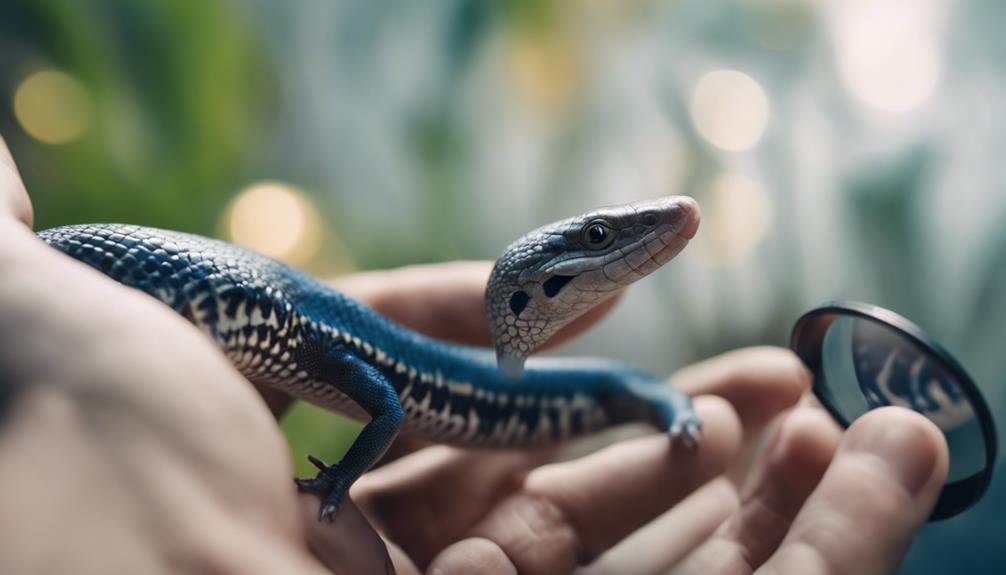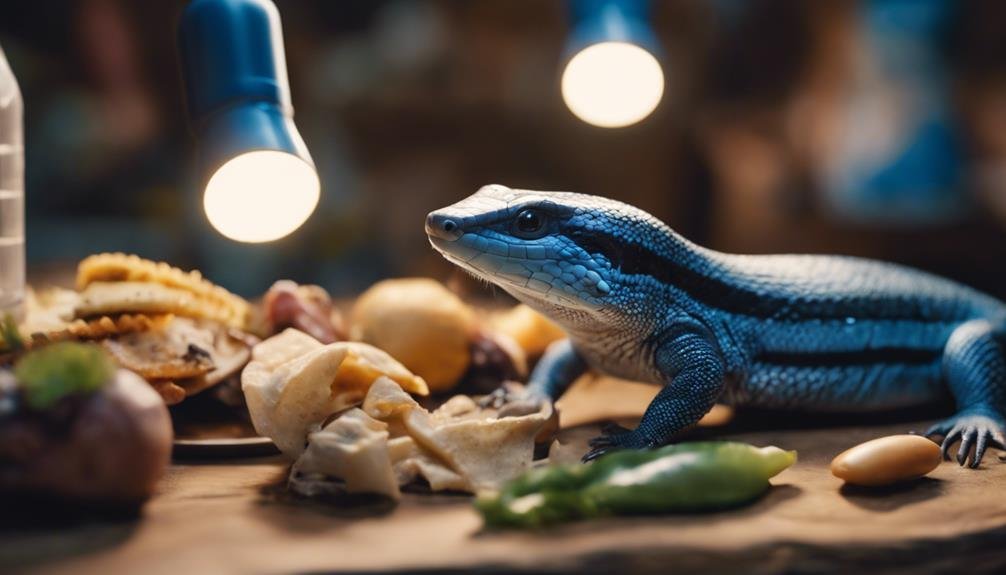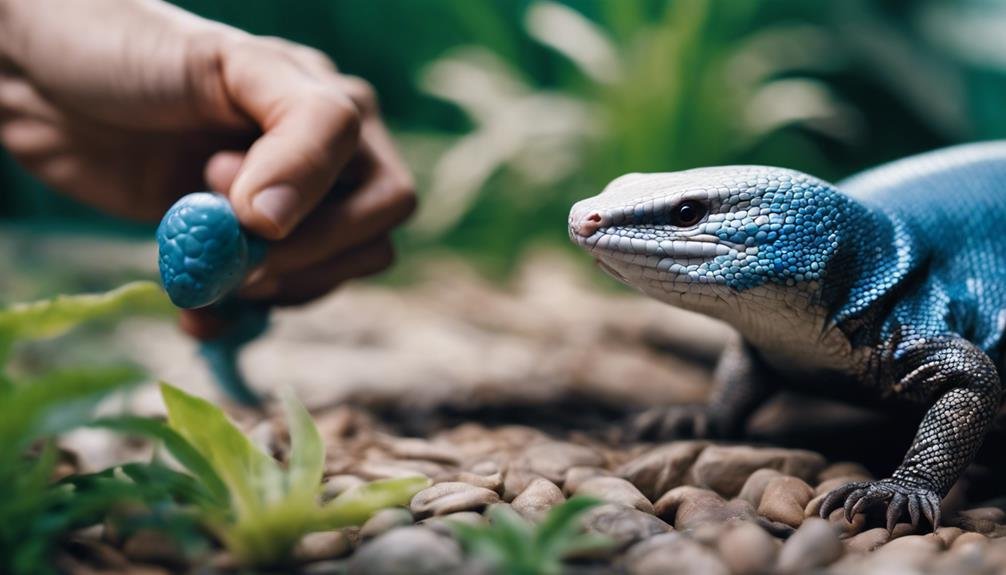You've probably heard myths about blue-tongued skinks being poisonous, but let's set the record straight. These fascinating reptiles are indeed not venomous or harmful to humans, and their vivid blue tongues serve more as a scare tactic against predators than a warning signal of toxicity. However, understanding why they've evolved such an unusual feature and how this affects their interaction with both their ecosystem and pet owners is key to appreciating these gentle creatures fully. If you're curious about what makes these skinks safe companions and how their unique biology influences their care, there's much to uncover that might surprise you.
Key Takeaways
- Blue-tongued skinks do not possess venom or poison, making them safe around humans.
- Their blue tongue serves as a defense mechanism to deter predators, not to harm.
- Misconceptions about their toxicity can be cleared up; they pose no threat to humans.
- Handling skinks is safe, provided you respect their space and handle them gently.
- Educating others on skink safety and their non-venomous nature promotes informed appreciation.
Understanding Blue-Tongue Skinks
In order to fully appreciate blue-tongued skinks, one must understand that, despite their alarming blue tongues, they aren't poisonous but use this feature as a defense mechanism. These intriguing reptiles possess a calm and docile personality, which has endeared them to many reptile enthusiasts as pets. Their distinctive blue tongue isn't just for show; it plays a vital role in their survival strategy.
When threatened, blue-tongued skinks will flash their vibrant tongue as a warning signal to potential predators. This unexpected display can startle or confuse predators, buying the skink valuable time to escape. But their defense mechanisms don't stop there. Mimicking snakes, they can tuck their legs and slither away, further deterring those who might want to make a meal of them. In extreme cases, they may even detach their tails to distract a predator, allowing them to flee to safety.
Understanding these behaviors helps you see that the blue tongue of these skinks is much more than a peculiar trait. It's a key part of their survival, serving as an effective defense mechanism that aids in their longevity in the wild.
Misconceptions About Venom
Many people mistakenly believe that blue-tongued skinks are venomous due to their striking tongue color, but they're actually harmless. This misconception about venom stems from a lack of understanding about these unique creatures and their defense mechanisms.
The vibrant blue tongue of skinks serves as a startling surprise to potential predators, making them appear larger and potentially harmful. However, this is merely a bluff; blue-tongued skinks aren't equipped with any venom or poison that could harm humans.
It's crucial to clear up these misconceptions about venom when it comes to blue-tongued skinks. Their intimidating appearance, including the sudden flash of their blue tongue, is their way of deterring predators, not a sign of toxicity. Despite their fearsome display, these reptiles are entirely safe to handle and pose no threat to humans.
Understanding that the blue tongue is a defense mechanism rather than a marker of venom helps dispel unnecessary fears and promotes a more informed appreciation for these fascinating creatures. They're a clear example of how appearances can be deceiving, especially in the animal kingdom, where survival often depends on such clever deceptions.
Safety Around Skinks


Understanding that blue-tongued skinks aren't venomous eases concerns, but it's also important to know how to safely interact with them. Skink safety is paramount not just for your well-being, but for the skinks' as well. Here's a concise guide to guarantee both you and these unique reptiles stay safe.
| Do's | Don'ts | If Injured |
|---|---|---|
| Observe from a distance to respect their space. | Do not attempt to handle or provoke them, as they may bite if threatened. | Contact wildlife rescue for assistance instead of trying to help the skink yourself. |
| Educate others about the importance of skink safety. | Avoid disturbing their natural habitat or removing them from the wild. | Follow the instructions given by wildlife professionals to secure the skink's best chance of recovery. |
| Use a camera to capture their beauty without interference. | Refrain from feeding them, as human food may not be suitable for their diet. | Ensure the skink is in a safe place away from predators until help arrives. |
| Be mindful of your pets, ensuring they don't threaten or chase the skinks. | Do not release pet skinks into the wild, as they may not survive. | Stay informed on how to prevent similar situations in the future. |
Skink Diet Insights
To guarantee your Blue-Tongued Skink thrives, it's vital to provide a balanced diet consisting of both plant and animal matter. Understanding that skinks are omnivores is the first step in grasping their dietary needs. Their diet should include a variety of proteins such as insects, snails, and small animals to cater to their carnivorous side. However, don't overlook the importance of fruits and vegetables, which are important for providing the necessary vitamins and minerals.
Skinks need vitamin and mineral supplements to make sure their diet is well-rounded, supporting their growth, development, and overall health. This balanced approach to nutrition isn't just about filling their stomachs; it plays a critical role in their longevity and well-being. Diet insights for Blue-Tongued Skinks emphasize the importance of diversity in their meals. Offering a mix of different food items not only meets their nutritional requirements but also keeps them interested in their food.
Skink Care Essentials


Caring for Blue-Tongued Skinks involves setting up a proper habitat that meets their specific needs for warmth, light, and space. Your dedication to creating an ideal environment is essential for their well-being and longevity. Here's what you need to know to make your skinks thrive:
- Climate Control Is Key: Install UVB lighting and heat lamps in your skink's enclosure to mimic their natural environment. This guarantees they absorb enough calcium and stay warm. Remember, a comfortable skink is a happy skink.
- Size Matters: Opt for a 40 to 55-gallon tank to give your skink ample room to explore, burrow, and relax. A spacious enclosure for a blue-tongued skink isn't a luxury—it's a necessity.
- Diet & Nutrition: A balanced diet rich in vegetables, insects, and occasional small animals, supplemented with essential vitamins and minerals, will keep your skink healthy and vibrant. Proper nutrition is the cornerstone of their care.
Learn more about blue-tongued skinks and their fascinating world. By understanding their needs, you're not just ensuring their survival; you're enriching your life with the joy and wonder these unique creatures bring.
Is the Size of a Blue Tongue Skink Related to its Level of Toxicity?
The size of a blue tongue skink is not related to its level of toxicity. Instead, their toxicity is dependent on their diet and environment. Proper blue tongue skink care size is essential for their well-being, but it does not determine their toxicity level. Always research and provide the right care for your pet.
Frequently Asked Questions
Can You Get Sick From a Blue Tongue Lizard?
You should take into account lizard hygiene, pet allergies, and handling precautions when interacting with a blue tongue lizard.
These lizards aren't poisonous, so touching or being near them isn't a health risk. However, always wash your hands after handling to prevent any possible allergic reactions or the spread of germs.
It's all about being cautious, not scared, so enjoy your time with these fascinating creatures.
Can Skinks Make You Sick?
You don't need to worry about skinks making you sick. Their diet and habitat cleanliness are key to keeping them healthy and safe for you to handle.
Always wash your hands after handling them or cleaning their space, as a precaution. Skinks, including blue-tongued ones, aren't known to transmit diseases to humans.
What Happens if You Touch a Blue Tongue Lizard?
If you touch a blue tongue lizard, you're usually in for a crucial experience, essential for pet bonding. However, always practice handling care to avoid stressing the lizard, which might lead to defensive behaviors.
Rarely, individuals might experience skin allergies, so it's good to wash your hands after handling. These lizards aren't harmful, and touching them can deepen your connection, just remember to be gentle and respectful to their needs.
Are Blue Tongue Skinks Harmful?
You don't need to worry about blue tongue skinks being harmful. Their skink temperament is quite docile, making them great for handling. They've adapted their habitat to avoid conflict, using their bright tongues to scare off predators rather than attack.
Their diet preferences also mean they're not interested in biting humans or pets. Instead, they munch on plants and small insects, focusing on a peaceful coexistence rather than aggression.
Conclusion
To sum up, you've got nothing to worry about with blue-tongue skinks. They're not poisonous or venomous, just misunderstood. Their bright blue tongues are for show, not harm.
So, if you're considering one as a pet, go for it! They're safe, gentle, and make fascinating companions. Just remember, proper care is key to keeping your skink healthy and happy.
Embrace the uniqueness of these creatures without any fear. They're sure to add a special touch to your life.


